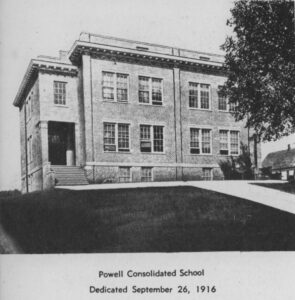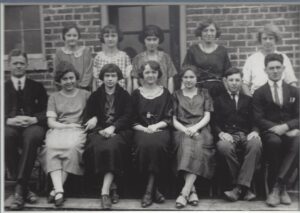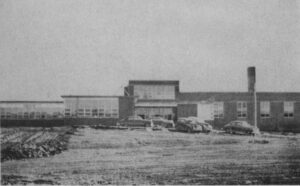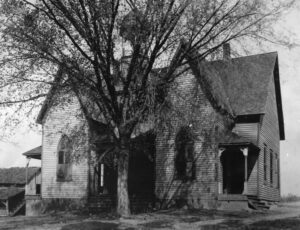The following “History of Education at Powell Station” was written by Mrs. Bessie Lindsey Scarbro probably in 1916. This history was copied from a handwritten notebook provided by the writer to be used in this centennial celebration of Glenwood Baptist Church.
The History of Education
at Powell Station
The first educational institution at Powell Station was erected between the years 1820 and 1830, forty years after Samuel Doak founded the first school in Tennessee. The land on which the building was placed was given by Maxwell and Isbel Gaston Brown and was situated one-half mile south of Powell Station across Beaver Creek on the Hardie Brown farm; hence, it was appropriately named Browns School House. The Browns were grandparents of Dr. J. D. Collier, Horace Brown, and J. E. Groner of Powell Station, and Henry and Luther Brown of Knoxville. Mr. John Bell, who resides two miles south of Powell Station, attended school at the old Browns School House in 1834, 82 years ago. Mr. Bell is now ninety years of age. At this early date Knoxville was a mere village; not even the main line of the East Tennessee, Virginia, and Georgia railroad had been built. There was very little cleared land; houses were some distance apart, and the roads were very poor. The people forded Beaver Creek when they needed to get from one side to the other.
The school building was constructed of logs donated, cut, hauled, and put in place by men of the neighborhood, thus giving us a striking example of the community spirit that was exercised by our forefathers. A large chimney stood at one end of the log structure. There was a fireplace five feet wide in which a big wood fire crackled on frosty mornings. Before “books” the small children would gather around the fire to warm their toes while the larger ones roasted chestnuts and the big boys exchanged “possum news” of the night before. The building was not ceiled overhead, and the joists were pealed poles that afforded the sturdy youths a good place for “skinning the cat” on rainy days. The same room was used for study hall, recitation hall, and gymnasium. The one window had no sash but was a mere opening with a shutter which was closed at night. The door had wooden hinges made by the neighbors. The lock was not a Yale lock but was a simple wooden latch placed over a stick poked through. The seats were made of logs split in half with pegs put in each end of the I log for legs. The seats had no backs and there were no desks.
In the early days, the puncheon floor was probably used, but later a plank one took its place. The scholars say that the planks were not nailed down and that quite an uproar would be heard as recess and “dinner” were announced. Clumpity, clumpity, clump went the timbers as the children ran over them. Even the neighbors some distance away knew when it was “books” and when it was play time by the groaning of the floor. No janitor service was needed in those days as the big boys chopped and carried wood, and the girls swept the house. The teacher had no special boarding place but visited around the scholars’ homes, thus coming in contact with every patron and being a guest in every home. The story is told that a young man living across Beaver Ridge from Browns School House took the teacher home with him to spend the night. On the way back to school the next morning the teacher stopped on the ridge and provided himself with an armful of black-gum switches, much to the dismay of the young man.
The people in those days seemed to carry out, in a way, some very good principles of education. With their meager opportunities, they performed their tasks well in playing the role of pioneer educators. In addition, a progressive spirit had seized the citizens of the community. The service which the dear old log house with its primitive construction had provided passed into history, and a new frame structure took its place about the year of 1857.
Miss Martha Finley was teaching in the log house when the frame one was built. The teacher and their scholars relocated and *as Oliver Wendell Holmes expressed it in his – Chambered Nautilus, “He left the past years dwelling for the new stole with soft steps its shining archway through, built up its idle doors, stretched in his last found home and knew the old no more.” The frame building had two doors opposite each other and six windows with glass in the sash. The room was ceiled and had a good floor. A heating stove stood in the center of the room, so you readily can see this building was quite an improvement over the old one. The planks that were used for flooring in the log house were made into seats for the new school, and these seats were used until the building was abandoned.
Browns School House was really a community center. Spelling matches were enjoyed by all folks of the neighborhood. It is said one patron became so interested in the spelling bees that he carried his Blue Back Speller to the field, and when he stopped “Old George” to rest the farmer studied the spelling book. The schoolhouse was also used as a preaching place for all denominations. Revival meetings were held there and a Union Sabbath School conducted. Circuit riders left their appointments from time to time. Among the names of ministers who conducted services at Browns School House we find Rev. Samuel West, Rev. Jonathan Bishop, and Rev. John Brown-“They being dead yet speak,” source unknown.
The teachers of Browns School sometimes came from another neighborhood, yet often times were residents of the immediate community. The following names were found among the many-Fount Gentry, George Magby, Hardie Brown, Martha Finley, William A. A. Conner, John Brown, Frank Sanders, Wilson Collier, Charles Nelson, and Thomas C. Karns. It is said Charles Nelson brought many new ideas into the school. He saw the need for a graded system and put it into practice to some extent.
In the early history of Browns School, patrons paid tuition, but before 1850 they began to get the benefit of the free school money derived from the State. The State, however, had collected a tax levy for school funds since 1816. The free school would be taught in the fall and a subscription school in the spring and summer. The course of study consisted mainly of the three “R’s” although some high school subjects were taught. T. C. Karns began the study of algebra under Hardie Brown. Charles Karns was at one time chairman of the Board of Directors for the Browns School District and issued certificates to teachers. Hardie Brown, who had been a student at Hiawassee College, came home and applied for a position of teacher at Browns School. Mr. Karns, with his meager education, conducted an oral examination asking the young collegian a few questions on arithmetic and grammar, etc., and granted him a certificate right then and there.
Let us see who some of the patrons of the Browns School were during this period of forty years. Maxwell and Isbel Gaston Brown lived near the sight of Mrs. Hardie Brown’s home, which was the old Brown homestead. Mr. Dooling, brotherin-law of Eli Cox, lived on what is now the Luther Brown farm. Mr. Brown’s father, John Brown, had bought it from Mr. Dooling. Elijah Johnson lived near the gap in the ridge where his son James now lives. “Uncle Sammie” Bell’s home was what is now the Reynolds place. Mrs. Reynolds was Uncle Sammie’s daughter. Wash and Aunt Sookie Bell lived near Bell’s Bridge in the old building preserved by their son,S. A. Bell. Robin Bell owned what later was known as the nursery farm which he sold to Westley Fox in the early sixties. Mr. Fox also owned the Hibbs place. Thomas Addison Bell was the son of Blackston and Elizabeth (Betsy) Bell. After the death of his parents, he lived with Uncle Hardie Brown and attended Perkins School.
In 1849 William and Margaret Lonas McClellan built the house where Sam P. Fox now lives and reared a large family. Rufus and the late Matthew McClellan were two of the family members. Frank Ragsdale, Dr. Ragsdale’s brother, owned Knoxville Brick Company’s farm.
At the time there was a store near the big spring in Powell Station, and the store keeper bought some advanced geography books. They were large in size and the first of the kind in the community. Mr. Ragsdale’s son purchased one of the books and walked into Browns School the next morning with the book under his arm. The scholars say the scene was one never to be forgotten. Aaron Gentry, who was Albert Gentry’s grandfather, owned Dr. Collier’s home place which stood near the road. The farm, however, changed hands until Mr. Stollzus, Miss Amanda Stollzus’ father, bought it and lived there during the Perkins School period. Samuel Tillery bought it from him. Wilson Parker, Eldridge Parker’s grandfather, lived on the Moore farm above the station. Mr. Child lived on Dr. Collier’s upper place. This is known as the old Lewis farm of which John Sharp’s farm was a part. Thomas Conner and his wife owned the farm where Alex Bishop now lives. Squire John Tunnell owned the Child farm above Glenwood Church which was the girlhood home of his wife, Talitha Wood Tunnell. William Lacy and wife lived above Squire Tunnell on the same road. John Wood lived on what is now Glenwood Farm owned by W. T. Ballou. Alfred Wood owned the Rutherford farm. Mrs. Rutherford was Mary Jane Wood. Rufus Wood lived on what is now Fayette Wood place. Wilson and Margaret Brown Groner reared their family on the Groner farm east of Powell Station. Charles Karns bought a part of the Josiah Armstrong farm in, 1846 and moved to the farm now owned by Mrs. W. W. Bishop. Ellison Armstrong lived where Gus Godfrey now lives. Thomas and Jane Brown Collier lived further down the valley below the Bell settlement. Spence Elkins owned the place where his son Columbus now lives. Eli Cox and Martha Yarnell lived across Beaver Ridge in Hines Valley. Abraham May lived in the community and was a patron of the school.
Dr. Abraham Hoover was a practicing physician of the early days, and had his office in the corner of Mr. McClellan’s yard. He was a very cheerful man and always enjoyed a joke.
Dr. John Ragsdale and wife Callie McBath Ragsdale came to Powell Station during the sixties and lived on the farm now owned by his son, Eugene Ragsdale. He doctored all of the folks of the neighborhood after Dr. Hoover had passed away. Even when I was a child, Dr. Ragsdale’s, name was a household word and the people looked on him as their friend in time of sickness.
In the year 1860 when Browns School was in its zenith, the railroad was built from Knoxville to Powell Station. Cord wood was shipped from Powell Station to Knoxville. Wood was the principle fuel at that time; even the locomotives were fired with wood. The extending of the railroad into the community encouraged a new occupation, that of cutting cordwood. Old settlers say it was quite an event when the first trains ran out. Farmers left their work and went to the top of the nearest hill to watch the “iron horse” make its way across the country. A station was made and named for Columbus Powell who had bought the Ragsdale place, now the Brickyard farm. Mrs. J. Allen Smith of the City Mills, the former Miss Lillie Powell, is the daughter of Mr. Columbus Powell.
For some years after the village was founded, Browns School was continued. As the population increased and the demand for a new school became agitated more and more, it. was decided to abandon the old Brown site and locate the new school at the station. A new site was decided upon and a 100-foot-front lot was donated by Dr. Ragsdale, in agreement with the request of Preston Bishop who sold the property to Dr. Ragsdale. The present site was the one chosen and the transfer was made to the directors.
In 1873 a school law was passed by the legislature providing for a state superintendent of public instruction, a county superintendent for each county, a city superintendent, and a board of three directors for each school district. The legislature provided for a state tax to help pay the expense of the school and to authorize counties and cities to levy additional tax for the same purpose. Professor T. C. Karns, Powell station, became the first superintendent of Knox County Schools and Dr. John Ragsdale, John Tunnell, and John Brown were the first school directors of the Eighth District. John M. Bishop and Charles Karns became directors later.
Interest in education was at a high tide in this community at that time. The citizens went to work and cut and hauled logs to the new mill. These logs were taken from the farms of Henry McClellan, Columbus Powell, and others. Everybody lent a hand and in 1874 the building was completed. Prior to this date, Sam M. Cooper, now of Fountain City, was going to school in Washington County and made the acquaintance of Professor William H. Perkins. Professor Perkins was the principal of the school in which Mr. Cooper was a student and later a teacher. This school was receiving aid from the “George Peabody Fund.”
When Mr. Cooper returned to Powell Station, he insisted that the Board of Directors employ Prof. Perkins as principal of the new school. The school was opened in the fall of 1874 with Prof. Perkins as principal and Mr. Cooper assistant. The directors made application for assistance from the “Peabody School Fund” and received $300.00 to be used for teachers’ salaries. Prof. Perkins and Mr. Cooper received a stated salary derived from the Peabody Fund, state and county school tax levy, and tuition. John M. Bishop canvassed the community for funds with which to help pay teachers’ salaries. The Perkins High School is said to be the first school in the county to receive aid from the Peabody Fund. The trustees of the Peabody Fund decided that they could best help the schools of the state by establishing a normal school for the training of teachers. Peabody College was established in Nashville in 1875 and the availability of this money from the Peabody School Fund soon came to an end. Prof. Perkins was retained as principal for four years at which time he resigned to go elsewhere. The good that was accomplished during these four years cannot be estimated as the influence from this school will radiate forever. Prof. Perkin’s death was mourned in 1879.
The Literary Society established at Perkins School was a great factor in the development of the oratorical and journalistic qualities of the students. Many a young man spoke equal to Daniel Webster.
The Beaver Creek News was the official journal of the Literary Society. The weekly public reading of the paper was a great event. Every young man was all ears to hear his name read out with that of his great girl.
The Anti Sweat Society with Will Armstrong as president was another organization that provided much fun and merriment for its members.
Did you ever throw a stone in a pond of water and watch the waves widen until they struck the soil at the edge of the pond? In this same pattern, the influence from the Perkins School will radiate on and on as long as time shall last. Students from this school have gone out into nearly every state in the union and have been a blessing to the world and also have reflected credit on their former home. Eternity alone will reveal the width and breadth, the height and the depth of the school’s great mission in this community.
After Prof. Perkins went away, good schools continued until 1891, at which time the secondary school system was established by the legislature. This school had course of study of ten grades and was great advantage in its day. Numbers of young men and young women have gone out from the secondary school at Powell Station and are succeeding in life. A number of them had no further school training. They are occupying responsible railroad positions; some are railway mail clerks, others are teachers, preachers, bookkeepers, lawyers, merchants, doctors, farmers, dentists, and other honorable occupations.
Since 1914 a one-year high school course has been taught. This brings us to the present (1916). Through the efforts of the county court and school officials, a new $15,000 school building has been erected, a four-year high school course will be taught, and a new day has dawned at Powell Station.
 On May 1, 1916, “The corner stone of the new building at Powell Station was laid Thursday afternoon in the presence of a large audience of people. The principal address of the The above was reported by the Knoxville Journal on Friday, May 1, 1916.
On May 1, 1916, “The corner stone of the new building at Powell Station was laid Thursday afternoon in the presence of a large audience of people. The principal address of the The above was reported by the Knoxville Journal on Friday, May 1, 1916.

Left to right: Gladys Easterly, Myrtle Hackworth (Gill),
Agnes Nickle, Roy Herrell, Cleo Gill (Spradlen),
Robert Presnell, Della Messamore (Taylor), Fred Child, Mae Naugher (Larew), Tillie Hood.
The Knox County School report for 1888 claimed that Knox County had the best school system in the state. It also indicated that there were 133 schools and 150 teachers which means that the one-room school house was very much the norm at that time. In 1916, Knox County appropriated $15,000 for a new school at Powell Station to replace the one built in 1874. The new school would provide a four-year high school course in addition to the eight-year elementary curriculum. The new building contained six rooms and a combined library and study hall. Mr. G. W. Morton was school principal.
 After World War II, new high school facilities were constructed on a seventeen-acre tract along Emory Road. The new Powell High School facilities were completed at a cost of approximately $500,000 and opened in September 1949. These facilities have been expanded many times since 1949 to include the following: home economics building, science wing, shop space, enlarged gymnasium and cafeteria, library wing, addition to the football stadium, track facilities, and other improvements.
After World War II, new high school facilities were constructed on a seventeen-acre tract along Emory Road. The new Powell High School facilities were completed at a cost of approximately $500,000 and opened in September 1949. These facilities have been expanded many times since 1949 to include the following: home economics building, science wing, shop space, enlarged gymnasium and cafeteria, library wing, addition to the football stadium, track facilities, and other improvements.
Then in the 1980s additional facilities were urgently needed to relieve the crowded conditions. During the 1983-1984 school year the construction of new facilities began. The construction workers, students, and teachers co-inhabited the school building during the time a complete renovation and enlargement of the facility was in progress. In the fall of 1985 a completely new building was available to welcome the students and teachers.
In January 1975 a new Powell Middle School was opened for students in grades six through eight. The facility was constructed along Emory Road west of the high school. This school serves some of the Brickey, Heiskell, and Dante areas in addition to the Powell area.
When the high school moved to new facilities in 1949, the elementary school continued to use the 1916 building. This old building was remodeled and enlarged in 1969. Then in 1986 the old 1916 building was torn down and replaced. These new facilities were completed in March 1988.
This article was originally published in the Glenwood Baptist Church Centennial Celebration Book (1890 – 1990).
This is being re-published by permission of Glenwood Baptist Church, 7212 Central Avenue Pike, Powell, Tennessee 37849.

